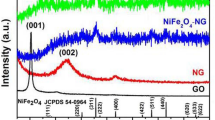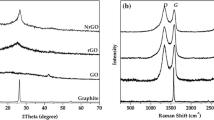Abstract
Herein, we demonstrate a facile one-step hydrothermal synthesis route to anchor ZnO nanoparticles on nitrogen and sulfur co-doped graphene sheets. The detailed material and electrochemical characterization have been carried out to demonstrate the potential of novel ZnO/NSG nanocomposite in Li-ion battery (LIBs) applications. The structure and morphology of nanocomposite were assessed by X-ray diffraction (XRD), Fourier transform infrared (FTIR), thermogravimetric analysis (TGA), scanning electron microscopy (SEM), and transmission electron microscopy (TEM). The as-synthesized ZnO/NSG nanocomposite has been studied as anode material in LIBs and delivered a high initial discharge capacity of 1723 mAh g−1, at the current density of 200 mA g−1. After 100 cycles, the ZnO/NSG nanocomposites demonstrated a high reversible capacity of 720 mAh g−1 and coulombic efficiency of 99.8%, which can be attributed to the porous three-dimensional network, constructed by ZnO nanoparticles and nitrogen and sulfur co-doped graphene. Moreover, the designed nanocomposite has shown excellent rate capability and lower charge transfer resistance. These results are promising and encourage further research in the area of ZnO-based anodes for next-generation LIBs.











Similar content being viewed by others
References
Kim SW, Seo DH, Ma X, Ceder G, Kang K (2012) Electrode materials for rechargeable sodium−ion batteries: potential alternatives to current lithium-ion batteries. Adv Eng Mater 2:710–721
Ji L, Lin Z, Alcoutlabi M, Zhang X (2011) Recent developments in nanostructured anode materials for rechargeable lithium-ion batteries. Energy Environ Sci 4:2682–2699
Zhang WJ (2011) A review of the electrochemical performance of alloy anodes for lithium-ion batteries. J Power Sources 196:13–24
Yoshio M, Wang H, Fukuda K (2003) Spherical carbon-coated natural graphite as a lithium-ion battery-anode material. Angew Chem Int Ed Engl 42:4203–4209
Wu YP, Jiang C, Wan C, Holze R (2002) Modified natural graphite as anode material for lithium ion batteries. J Power Sources 111:329–334
Wang Z, Zhang H, Li N, Shi ZJ, Gu ZN, Cao GP (2010) Laterally confined graphene nanosheets and graphene/SnO2 composites as high-rate anode materials for lithium-ion batteries. Nano Res 3:748–756
Wu ZS, Ren W, Wen L, Gao L, Zhao J, Chen Z, Zhou G, Li F, Cheng H (2010) Graphene anchored with co(3)o(4) nanoparticles as anode of lithium ion batteries with enhanced reversible capacity and cyclic performance. ACS Nano 4:3187–3194
Lian PC, Zhu XF, Xiang HF, Li Z, Yang WS, Wang HH (2010) Enhanced cycling performance of Fe3O4–graphene nanocomposite as an anode material for lithium-ion batteries. Electrochim Acta 56:834–840
Wang HL, Cui LF, Yang Y, Casalongue HS, Robinson JT, Liang YY, Cui Y, Dai HJ (2010) Mn3O4–graphene hybrid as a high-capacity anode material for lithiumion batteries. J Am Chem Soc 132:13978–13980
Fang W, Zhang NQ, Fan LS, Sun KN (2016) Bi2O3 nanoparticles encapsulated by three-dimensional porous nitrogen-doped graphene for high-rate lithium ion batteries. J Power Sources 333:30–36
Xu YT, Guo Y, Li C, Zhou XY, Tucker MC, Zhu X, Sun R, Wong CP (2015) Graphene oxide nano-sheets wrapped Cu2O microspheres as improved performance anode materials for lithium ion batteries. Nano Energ 11:38–47
Li HP, Wei YQ, Zhang YG, Yin FX, Zhang CW, Wang GK, Bakenov Z (2016) Synthesis and electrochemical investigation of highly dispersed ZnO nanoparticles as anode material for lithium-ion batteries. Ionics 22:1387–1393
Huang XH, Xia XH, Yuan YF, Zhou F (2011) Porous ZnO nanosheets grown on copper substrates as anodes for lithium ion batteries. Electrochim Acta 56:4960–4965
Wang HB, Pan QM, Cheng YX, Zhao JW, Yin GP (2009) Evaluation of ZnO nanorod arrays with dandelion-like morphology as negative electrodes for lithium-ion batteries. Electrochim Acta 54:2851–2855
Li P, Liu Y, Liu JY, Li ZT, Wu GL, Wu MB (2015) Facile synthesis of ZnO/mesoporous carbon nanocomposites as high-performance anode for lithium-ion battery. Chem Eng J 271:173–179
Yang GZ, Song HW, Cui H, Liu YC, Wang CX (2013) Ultrafast Li-ion battery anode with superlong life and excellent cycling stability from strongly coupled ZnO nanoparticle/conductive nanocarbon skeleton hybrid materials. Nano Energ 2:579–585
Gao S, Fan RQ, Li LS, Yang YL (2016) Porous carbon-coated ZnO nanoparticles derived from low carbon content formic acid-based Zn(II) metal-organic frameworks towards long cycle lithium-ion anode material. Electrochim Acta 215:171–178
Novosolev KS, Geim AK, Morozov SV, Jiang D, Zhang Y, Dubonos SV, Grigorieva IV, Firsov AA (2004) Electric field effect in atomically thin carbon films. Science 306:666–669
Liu YH, Xue JS, Zheng T, Dahn JR (1996) Mechanism of lithium insertion in hard carbons prepared by pyrolysis of eposxy resins. Carbon 34:193–200
Wang GX, Shen XP, Yao J, Park J (2009) Graphene nanosheets for enhanced lithium storage in lithium ion batteries. Carbon 47:2049–2053
Hu AP, Chen XH, Tang QL, Zeng B (2014) Hydrothermal controlled synthesis of Fe3O4 nanorods/graphene nanocomposite for high-performance lithium ion batteries. Ceram Int 40:14713–14725
Shan H, Li XF, Cui YH, Xiong DB, Yan B, Li DJ, Lushington A, Sun XL (2016) Sulfur/nitrogen dual-doped porous graphene aerogels enhancing anode performance of lithium ion batteries. Electrochim Acta 205:188–197
Wang MY, Huang Y, Chen XF, Wang K, Wu HW, Zhang N, Fu HT (2017) Synthesis of nitrogen and sulfur co-doped graphene supported hollow ZnFe2O4 nanosphere composites for application in lithium-ion batteries. J Alloy Compd 691:407–415
Lu WB, Luo YL, Chang GH, Sun XP (2011) Synthesis of functional SiO2-coated graphene oxide nanosheets decorated with Ag nanoparticles for H2O2 and glucose detection. Biosens Bioelectron 26:4791–4797
Pradhan GK, Padhi DK, Parida KM (2013) Fabrication of α-Fe2O3 nanorod/RGO composite: a novel hybrid photocatalyst for phenol degradation. ACS Appl Mater Interfaces 5:9101–9110
Hu T, Sun X, Sun HT, Yu MP, Lu FY, Liu CS, Lian J (2013) Flexible free-standing graphene-TiO2 hybrid paper for use as lithium ion battery anode materials. Carbon 5:322–326
Stankovich S, Dikin DA, Piner RD, Kohlhaas KA, Kleinhammes A, Jia YY, Wu Y, Nguyen SBT, Ruoff RS (2007) Synthesis of graphene-based nanosheets via chemical reduction of exfoliated graphite oxide. Carbon 45:1558–1565
Nethravathi C, Rajamathi M (2008) Chemically modified graphene sheets produced by the solvothermal reduction of colloidal dispersions of graphite oxide. Carbon 46:1994–1998
Su Y, Zhang Y, Zhuang Y, Zhuang XD, Li S, Wu DQ, Zhang F, Feng XL (2013) Low-temperature synthesis of nitrogen/sulfur co-doped three-dimensional graphene frameworks as efficient metal-free electrocatalyst for oxygen reduction reaction. Carbon 62:296–301
Ren XP, Ren XD, Pang LQ, Zhang YX, Ma Q, Fan HB, Liu SZ (2016) MoS2/sulfur and nitrogen co-doped reduced graphene oxide nanocomposite for enhanced electrocatalytic hydrogen evolution. Int J Hydrogen Energy 41:916–923
Hmar JJL, Majumder T, Dhar S, Mondal SP (2016) Sulfur and nitrogen co-doped graphene quantum dot decorated ZnO nanorod/polymer hybrid flexible device for photosensing applications. Thin Solid Films 612:274–283
Lai TL, Lai YL, Yu JW, Shu YY, Wang CB (2009) Microwave-assisted hydrothermal synthesis of coralloid nanostructured nickel hydroxide hydrate and thermal conversion to nickel oxide. Mater Res Bull 44:2040–2044
Shen XY, Mu DB, Chen S, Wu BR, Wu F (2013) Enhanced electrochemical performance of ZnO-loaded/porous carbon composite as anode materials for lithium ion batteries. ACS Appl Mater Interfaces 5:3118–3125
Guo R, Yue WB, An Y, Ren YM, Yan X (2014) Graphene-encapsulated porous carbon-ZnO composites as high-performance anode materials for Li-ion batteries. Electrochim Acta 135:161–167
Zhang HH, Liu XQ, He GL, Zhang XX, Bao SJ, Hu WH (2015) Bioinspired synthesis of nitrogen/sulfur co-doped graphene as an efficient electrocatalyst for oxygen reduction reaction. J Power Sources 279:252–258
Niu WZ, Xu HB, Guo YM, Li YG, Ye ZZ, Zhu LP (2015) The effect of sulfur on the electrical properties of S and N co-doped ZnO thin films: experiment and first-principles calculations. Phys Chem Chem Phys 17:16705–16708
Amjadi M, Manzoori JL, Hallaj T, Azizi N (2016) Sulfur and nitrogen co-doped carbon quantum dots as the chemiluminescence probe for detection of Cu2+ ions. J Lumin 182:246–251
Lee JW, Ahn T, Soundararajan D, Ko JM, Kim JD (2011) Non-aqueous approach to the preparation of reduced graphene oxide/a-Ni(OH)2 hybrid composites and their high capacitance behavior. Chem Commun 47:6305–6307
Huang XH, Xia XH, Yuan YF, Zhou F (2011) Porous nanosheets grown on copper substrates as anodes for lithium ion batteries. Electrochim Acta 56:4960–4965
Zainelabdin A, Amin G, Zaman S, Nur O, Lu J, Hulman L, Willander M (2012) Cuo/ZnO nanocorals synthesis via hydrothermal technique: growth mechanism and their application as humidity sensor. J Mater Chem 22:11583–11590
Hu T, Xie M, Zhong J, Sun HT, Sun X, Scott S, George SM, Liu CS, Lian J (2014) Porous Fe2O3 nanorods anchored on nitrogen-doped grpahenes and ultrathin Al2O3 coating by atomic layer deposition for long-lived lithium ion batteries anode. Carbon 76:141–147
Sun CW, Sun J, Xiao GL, Zhang HR, Qiu XP, Li H, Chen LQ (2006) Mesoscale organization of nearly monodisperse flowerlike ceria microspheres. J Phys Chem B 110:13445–13452
Li D, Muller MB, Gilje S, Kaner RB, Wallace GG (2008) Processable aqueous dispersions of graphene nanosheets. Nat Nanotechnol 3:101–105
Zhang Q, Chen H, Han X, Cai J, Yang Y, Liu M, Zhang K (2016) Graphene-encapsulated 3D hierarchical ternary zinc-nickel-cobalt oxide microsphere constructed from highly porous ultrathin nanosheets for enhanced lithium storage. Chem Sus Chem 9:186–196
Zhang Q, Wang J, Dong J, Ding F, Li X, Zhang B, Yang S, Zhang K (2015) Facile general strategy toward hierarchical mesoporous metal oxides arrays on three-dimensional macroporous foam with superior lithium storage properties. Nano Energy 13:77–91
Paek SM, Yoo EJ, Honma I (2009) Enhanced cyclic performance and lithium storage capacity of SnO2/graphene nanoporous electrodes with three-dimensionally delaminated flexible structure. Nano Lett 9:72–75
Levi MD, Aurbach D (1997) Diffusion coefficients of lithium ions during intercalation into graphite derived from the simultaneous measurements and modeling of electrochemical impedance and potentiostatic intermittent titration characteristics of thin graphite electrodes. J Phys Chem B 101:4641–4647
Acknowledgments
This work was supported by the National Natural Science Fund (Grant no. 51074050) and the National High Technology Program (863 Project) (Grant no. 2009AA03Z529).
Author information
Authors and Affiliations
Corresponding author
Rights and permissions
About this article
Cite this article
Yang, C., Qing, Y., An, K. et al. ZnO nanoparticles anchored on nitrogen and sulfur co-doped graphene sheets for lithium-ion batteries applications. Ionics 24, 3781–3791 (2018). https://doi.org/10.1007/s11581-018-2555-x
Received:
Revised:
Accepted:
Published:
Issue Date:
DOI: https://doi.org/10.1007/s11581-018-2555-x




